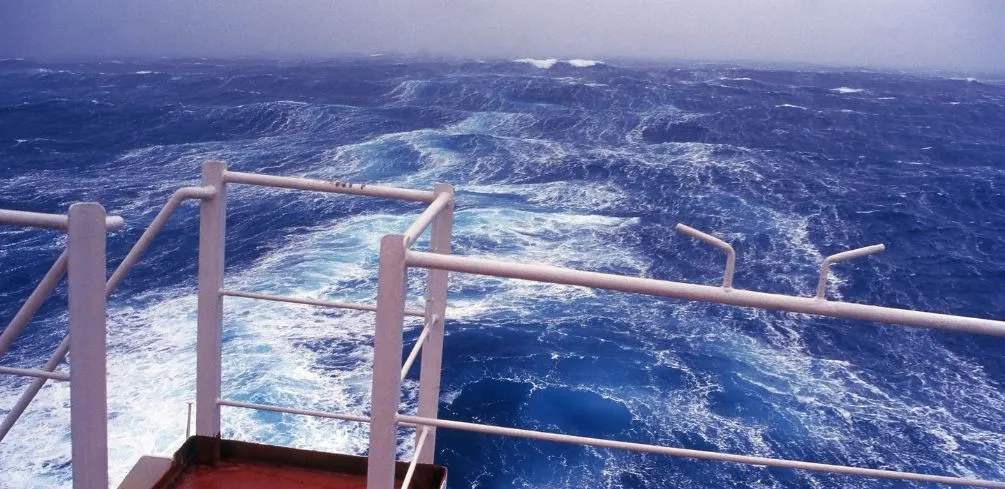Ah, the sea. A beautiful and mysterious place that many of us find ourselves drawn to. There’s something calming about the ocean’s vastness, its majesty, and its power.
But with that power comes danger when it unleashes a storm at sea. It can be a scary and sometimes deadly situation, so it’s important to know how to stay safe during a storm while out on the open water. That’s why I’m going to share some of my best strategies for staying safe during a storm at sea.
We all know that storms can come up suddenly and without warning, so it pays to always be prepared when you’re out on the water. Before heading out, make sure you have all of your safety gear – life vests, flares, first aid kits – as well as an emergency plan in place should things go wrong. And if you spot signs of an approaching storm, such as choppy seas or turbulent wind gusts, take action immediately by seeking shelter or returning to shore if possible.
No matter how prepared you are for a storm at sea or how much knowledge you may have about them, sometimes they can still catch us off-guard and put us in harm’s way. In the next section of this article, I will outline further strategies for staying safe during a storm at sea so you can be ready for whatever Mother Nature throws your way!
Preparation Before Leaving Shore
Preparing for a storm at sea requires absolute dedication – nothing should be left to chance! Storm proofing your vessel and thoroughly reviewing the pre-voyage checklist is essential. You must also stay up to date with the latest weather predictions, and ensure that you plan a safe route. Sea safety should be your number one priority when it comes to sailing in stormy conditions.
Creating a detailed plan of action before setting sail is an important step toward staying safe during a storm. Knowing exactly what to do in any given situation can make all the difference between life and death.
Make sure you map out your route carefully and identify any potential trouble spots before leaving shore. If possible, have multiple backup plans ready just in case you need to change course quickly due to unexpected weather changes or strong winds.
It’s also incredibly important to have the right equipment on board, such as life jackets, flares, and other safety gear.
Take some time to assess the condition of these items before leaving shore; they could save your life if something goes wrong! Having an emergency kit stocked with basic supplies like food, water, flashlights, and first aid supplies is also essential for surviving a storm at sea. Being prepared for whatever Mother Nature throws your way will give you peace of mind and increase your chances of staying safe during a stormy voyage.
Weather Tracking And Updates
Once the preparations have been completed, it’s time to pay attention to weather tracking and updates before setting sail. It’s important to stay abreast of the latest storm information and forecasts to ensure sea safety while sailing.
Weather tracking can be done in several ways. For example, a sailor can check local weather forecasts through TV or radio broadcasts, as well as online sources such as the National Weather Service website. Additionally, sailors can use smartphone apps that provide up-to-date storm information and severe weather warnings.
Sailors should also consider monitoring real-time data from buoys located throughout the ocean. The buoys collect data about wave height, wind speed and direction, water temperature, air pressure, and other factors, which can help sailors make decisions regarding sea safety.
By staying informed of current weather conditions before leaving shore, sailors can avoid potentially dangerous situations at sea during a storm.
It is imperative for any sailor to be aware of their environment in order to remain safe when sailing during a storm. Being prepared before leaving shore is essential for avoiding danger on the open seas; however, staying up-to-date on weather tracking and updates throughout the voyage is just as important for ensuring safe sailing practices and avoiding storms altogether.
By utilizing both preparation and real-time data collection resources, sailors will be able to make smart decisions that will keep them safe while navigating at sea during a storm.
Safety Equipment Aboard Ship
Safety equipment aboard a ship is like a knight in shining armor, protecting you from the unpredictable storms of the sea. Life jackets are essential for keeping people afloat in case of an emergency. Make sure everyone aboard knows exactly where the life jackets are stored and how to use them.
Life rafts should also be onboard and readily available in case of an emergency evacuation. Additionally, every boat should have a first aid kit that is properly stocked and regularly checked for expired items.
Fire extinguishers can help put out small fires before they become large and uncontrollable, so make sure to have several on board at all times. Lastly, navigation charts should always be up-to-date so that you know your exact location at any given time.
When it comes to staying safe during a storm at sea, having the right safety equipment is essential to survival. Without these items aboard your vessel, there is an increased risk of injury or death when facing hazardous conditions such as strong winds and rough seas.
So ensure that you take the proper precautions by stocking your vessel with life jackets, life rafts, first aid kits, fire extinguishers, and navigation charts – they could ultimately save your life someday!
Emergency Procedures
The safety equipment aboard the ship is essential, but it’s also important to be prepared for a storm at sea. Knowing what emergency procedures to follow can help ensure your safety and that of your crew.
First, make sure you have emergency contacts in place for when things go wrong. Having someone to call outside of your ship’s crew can be invaluable if you need assistance during an emergency situation. Make sure everyone on board knows who these contacts are in case of an emergency at sea.
In addition to having emergency contacts, it’s also important to be aware of weather alerts and other emergency notifications. Being up-to-date on the latest information can help you stay out of harm’s way and avoid dangerous situations.
It’s also important to have emergency supplies like food, water, and medical supplies available on board just in case they’re needed during a storm at sea.
Lastly, make sure everyone on board has received the proper training and instruction before heading out into the open ocean. Knowing how to respond effectively during an emergency situation is critical for staying safe in any environment, especially one as unpredictable as the sea can be.
Emergency communications should also be established prior to setting sail so that communication with people outside the ship is possible if needed.
After The Storm Passes
When the storm passes, it’s time to take stock of what’s happened. Like a phoenix rising from the ashes, the ship must be brought back up to speed.
Here are three steps to help you get there:
- Post-Storm Navigation: Make sure to check all navigational equipment and charts for accuracy, and make sure you can see clearly in all directions. Pay special attention to any debris or obstacles that may have been left behind in the wake of the storm.
- Post-Storm Visibility: Position yourself so you can get a clear view of your surroundings and survey the damage that has been done in order to assess what repairs will have to be made. Keep an eye out for any potential hazards such as floating debris, broken masts, or other vessels in distress.
- Post-Storm Repairs and Clean-up: Once you’ve identified what needs repair, take the necessary steps to begin fixing up the ship and clean up any mess that’s been left behind from the storm. Make sure everyone on board is safe and accounted for before attempting any repairs or clean-up operations.
Now that you know how to stay safe during a storm at sea and how to prepare for after it passes, nothing can stop you from having a safe journey on your next sailing adventure!
Frequently Asked Questions
What Type Of Clothing Should I Wear During A Storm At Sea?
When heading out to sea during a storm, the right clothing is essential for safety. It’s important to wear weatherproof clothing that will keep you dry and warm while protecting you from the elements.
Storm-proof gear such as waterproof jackets, non-slip shoes, and foul-weather gear should be worn to ensure your safety in extreme weather conditions.
Keeping yourself dry is key when it comes to staying safe during a storm at sea. Waterproof jackets are a great way to stay dry and warm while also providing protection from the wind and rain. Non-slip shoes can help prevent slips and fall on wet decks or slippery surfaces, while foul-weather gear can protect against wind chill, heavy rain, and other elements of bad weather.
Taking the right precautions before heading out onto the water can make all the difference in keeping you safe during a storm at sea. Wearing weatherproof clothing and storm-proof gear such as waterproof jackets, non-slip shoes, and foul-weather gear will help ensure your safety when dealing with extreme weather conditions.
Staying dry is an important part of maintaining your comfort and safety while out on the open seas.
How Can I Ensure My Boat Is Seaworthy Before Going Out?
When preparing to take a boat out on the open sea, it’s essential to ensure that your vessel is seaworthy. Boat maintenance and safety checks should always be taken prior to departure, as this can help minimize risks during rough weather. To make sure your boat is in good condition, there are several steps you need to take before setting sail.
The first step is to inspect the hull of the boat for any signs of wear or damage. You should also check that all of the necessary safety equipment is in proper working order and that you have enough life preservers for everyone aboard.
Additionally, it’s important to look over all of your navigational tools and make sure they are up-to-date. Finally, you’ll want to check any weather forecasts for the area you plan on sailing through so that you can be prepared if a storm arises.
Once your boat is ready for departure, it’s essential to adhere to safety protocols while at sea. This includes staying alert and aware of potential hazards such as rocks or other vessels, avoiding areas with strong currents or winds, and having someone aboard who knows how to handle an emergency situation if one arises.
Additionally, it’s important to know basic marine navigation techniques so that you can navigate safely even in bad weather conditions.
By completing these safety checks before departing and following safe practices while out at sea, boaters can ensure their vessel remains seaworthy even during storms. Knowing what steps need to be taken ahead of time will give you peace of mind knowing that your boat is well-equipped and prepared for whatever may come its way while out at sea!
What Happens If A Crew Member Is Injured During A Storm At Sea?
When the sea is raging and a storm is brewing, it’s essential to be prepared for any possible emergency situation. A crew member may be injured during a storm at sea, and it’s essential to have an emergency protocol in place to ensure their safety.
Knowing what to do when an accident occurs can help prevent injury and provide the best chance of rescue.
If a crew member is injured during a storm at sea, the first step is to assess the situation and take appropriate action. Boat evacuation should be considered if the person needs immediate medical attention or if conditions on board become dangerous.
An experienced captain or rescue team should also be contacted for assistance in an emergency. It’s also important that all other crew members remain calm and follow safety protocols, such as wearing life jackets, securing items on board the boat, and avoiding areas with high winds or waves.
To avoid these types of situations altogether, it’s wise to make sure your boat is seaworthy before setting sail. This includes checking navigation equipment, ensuring all passengers are wearing life jackets, and familiarizing yourself with local weather forecasts – so you don’t get caught out like a sailor in a hurricane!
Taking the time to prepare ahead of time can save you from having to face an unexpected storm at sea – which could have catastrophic consequences if not managed correctly.
How Often Should I Check The Weather Forecast Before Going Out?
I’m sure I’m not alone in wanting to stay safe out on the sea during a storm, but it all starts with checking the weather forecast. How often should I check the forecast before going out? Knowing this information is essential to staying safe.
The frequency of checking the weather forecast will depend on a few factors, such as how long my journey is and where I am headed. If I am heading out for an extended period of time, it’s important that I check the forecast every day or two.
This way, I’ll know what kind of conditions to expect and can adjust my route if necessary. For shorter trips, checking the forecast regularly would also be a good idea since storms can move quickly and unpredictably.
In addition to actively monitoring the weather, there are other things that can help me stay informed about potential storms while at sea.
A few steps I can take include the following:
- Checking marine forecasts from reliable sources such as NOAA
- Installing apps that provide up-to-date information on wind speed, wave height, and more
- Staying connected with other mariners in my area who may have local knowledge about upcoming weather patterns
By taking these proactive steps and knowing when to check the weather forecast before setting sail, I can better prepare myself for any unexpected storms at sea and ensure my safety.
Is There A Way To Prevent My Boat From Capsizing During A Storm?
I’m sure you’ve heard the horror stories of boats capsizing during a storm at sea. It’s a frightening thought that can cause even experienced sailors to be hesitant about setting sail in bad weather. But is there a way to prevent your boat from capsizing during a storm?
The answer is yes! By following some simple storm prevention strategies, you can ensure your boat’s stability during storms and avoid any chance of capsizing.
When planning for your trip, make sure to check the weather forecast before heading out. This will give you an idea of what kind of conditions you may encounter while out at sea and help you prepare accordingly. You should also pay attention to signs that could indicate an oncoming storm, such as changes in wind speed or direction, sudden drops in temperature, or dark clouds appearing on the horizon.
To prevent your boat from capsizing during a storm, there are several tips that can help keep it stable. Start by ensuring the boat is balanced with the weight evenly distributed between both sides. To do this, keep all loose items securely stowed away and avoid filling compartments with too much weight on one side of the boat.
For added protection against high waves and strong winds, install additional stabilizers or anchors along the sides of your vessel. Additionally, make sure all safety equipment like life jackets and flares are easily accessible in case of an emergency situation.
In order to stay safe while out at sea in bad weather conditions, it’s important to understand how to prevent your boat from capsizing during a storm.
By checking the weather forecast ahead of time and following these avoiding capsizing tips like evenly distributing weight around the vessel and installing stabilizers or anchors for extra support, you’ll be able to ensure your boat’s stability when faced with storms at sea and reduce any chance of capsizing.
Conclusion
As a sailor, knowing how to stay safe during a storm at sea can be the difference between life and death. By following these simple tips, you’ll become better prepared for any stormy seas that come your way.
Wearing protective clothing is essential; it helps keep you warm and dry while also providing protection from the elements. Making sure your boat is seaworthy before heading out to sea is also important – make sure to check all of the necessary equipment and safety features before setting sail. In addition, it’s important to check the weather forecast often so that you can plan accordingly and know when it’s best to stay in port.
Finally, if something does go wrong, having a plan in place for dealing with injuries or worse can make all the difference in an emergency situation. Preparation and knowledge are key when it comes to staying safe during a storm at sea – by taking all of these steps into consideration.
You’ll find yourself ready for whatever rough weather might come your way. Just as Odysseus navigated his way through treacherous waters during his epic journey home, we, too, must be well equipped with knowledge and forethought in order to brave the storms of life successfully.





